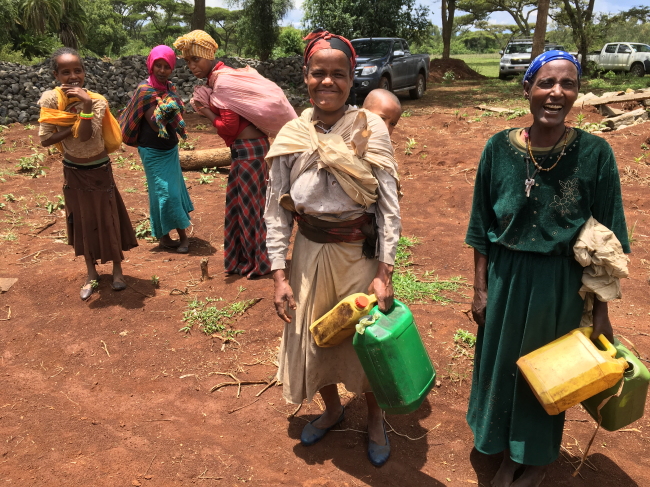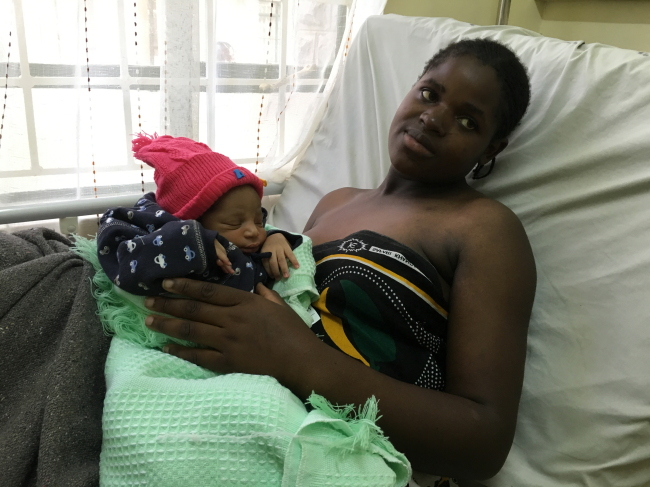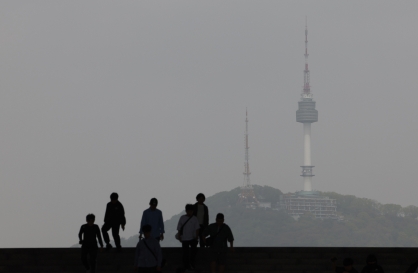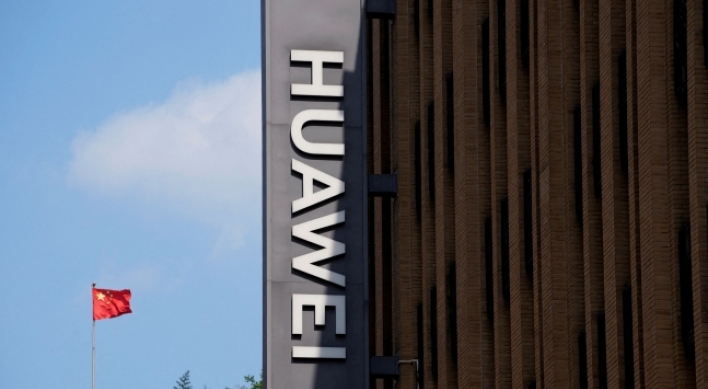KOICA supports public health improvement in Ethiopia, Kenya
By Shin Hyon-heePublished : May 16, 2016 - 17:20
GURAGE/KITENGELA, Ethiopia/Kenya -- Fatima Surel, 30, walks four hours twice daily to get water, carrying her 2-year-old son Fuad on her back far away from her small village in Adoshe, some 170 kilometers southwest of Addis Ababa.
Yet the water that filled her two 1-gallon (3.8 liters) bottles was barely transparent, tainted with red clay, dirt and other indiscernible substances. She knows the water cannot be safe, but it is the only source she can access.
“It’s really heavy to carry these, and because of the long distance, I can only carry a little,” said Surel, a mother of three boys, the others aged 3 and 5.
“It’s so difficult to get water but I just fetch whatever I can in this area because I need it for drinking, washing my children and other household chores.”
Yet the water that filled her two 1-gallon (3.8 liters) bottles was barely transparent, tainted with red clay, dirt and other indiscernible substances. She knows the water cannot be safe, but it is the only source she can access.
“It’s really heavy to carry these, and because of the long distance, I can only carry a little,” said Surel, a mother of three boys, the others aged 3 and 5.
“It’s so difficult to get water but I just fetch whatever I can in this area because I need it for drinking, washing my children and other household chores.”

Like her, the majority of families in the Gurage Zone face the pressing daily challenge of water shortage and unclean water that results in diarrhea and other waterborne epidemics.
As of 2015, around 57 percent of the Ethiopian population has access to safe water, according to KOICA. The figure is a mere 49 percent for those living in rural regions, whereas 93 percent of urbanites enjoy clean water.
Some 413,000 Ethiopians die every year from diarrhea. It is the fifth highest driver of deaths among children under 5.
“There’re no other springs in this area. People who drink this water usually get sick and (it) even causes death because it contains bacteria and other harmful substances,” said Feyesel Zenu, a 28-year-old Adoshe villager.
To help tackle the issue and improve the residents’ health conditions, the Korea International Cooperation Agency set out in 2013 to lay water pipelines totaling 170 kilometers and install 190 supply facilities at places such as public health centers and schools in Gurage.
The $8.4 million program is expected to benefit 73,000 residents in two countries once completed in the latter half of next year. Pipeline construction is currently under way by Kunhwa Consulting & Engineering Co., a Seoul-headquartered builder.
To ensure water quality, the agency is also carrying out a separate campaign to help villagers build new toilets and provide sanitation education.
About 70 percent of households have a toilet at home, but half of them are merely a shallow hole in their backyards without any partition or even a lid, said Kwon Hyun-jin, the program manager and a researcher of the Seoul-based Re-shaping Development Institute.
“There is a sufficient amount of water around the catchment basin, but the problem lies with the management of water quality and poor supply system,” she said.
“In rainy seasons, runoff occurs everywhere, contaminating water, and flies breed among waste material. These have been the main causes of diarrhea and other (potentially) fatal waterborne diseases.”
Alongside the project, KOICA is conducting another parallel experiment to assess the impact of water access on the outbreak of diarrhea among children under 5. It targets a total of 48 small villages, half of them serving as a control group. The results will also be published in the peer-reviewed journal Trials, according to Doh Young-ah, the country director of the grant agency’s Ethiopia office.
“We’ve had a variety of people who became sick from water and died. Thanks to KOICA’s efforts, we’re optimistic and excited to wait for the results from drinking clean water,” said Sheriadin Awol, 70, an elder of the village of Ambrte.
Heiru Shifa, head of the Gurage Zone’s water mines and energy department, noted that around 40 percent of the region’s residents take more than one hour to reach a water spring, with some walking as far as 7 kilometers.
“Female family members are often tasked with the job so girls often miss classes and even drop out of school. And it also affects the overall household productivity,” he said.
“When the work is completed, the water will be managed by the people themselves, for which we plan to create a user association and write a manual.”
Medical support in Kenya
As part of efforts to shore up public health in East Africa, KOICA built a hospital in Kitengela, Kenya in 2010.
The project was initiated in 2008 following the Kenyan government’s request to help meet growing needs for medical services in the city of 680,000, about 50 kilometers away from capital Nairobi.
By the national average, one doctor is responsible for about 25,000, whereas a Kitengela surgeon is in charge of some 76,000, Kenya 2010 official data shows.
As of 2015, around 57 percent of the Ethiopian population has access to safe water, according to KOICA. The figure is a mere 49 percent for those living in rural regions, whereas 93 percent of urbanites enjoy clean water.
Some 413,000 Ethiopians die every year from diarrhea. It is the fifth highest driver of deaths among children under 5.
“There’re no other springs in this area. People who drink this water usually get sick and (it) even causes death because it contains bacteria and other harmful substances,” said Feyesel Zenu, a 28-year-old Adoshe villager.
To help tackle the issue and improve the residents’ health conditions, the Korea International Cooperation Agency set out in 2013 to lay water pipelines totaling 170 kilometers and install 190 supply facilities at places such as public health centers and schools in Gurage.
The $8.4 million program is expected to benefit 73,000 residents in two countries once completed in the latter half of next year. Pipeline construction is currently under way by Kunhwa Consulting & Engineering Co., a Seoul-headquartered builder.
To ensure water quality, the agency is also carrying out a separate campaign to help villagers build new toilets and provide sanitation education.
About 70 percent of households have a toilet at home, but half of them are merely a shallow hole in their backyards without any partition or even a lid, said Kwon Hyun-jin, the program manager and a researcher of the Seoul-based Re-shaping Development Institute.
“There is a sufficient amount of water around the catchment basin, but the problem lies with the management of water quality and poor supply system,” she said.
“In rainy seasons, runoff occurs everywhere, contaminating water, and flies breed among waste material. These have been the main causes of diarrhea and other (potentially) fatal waterborne diseases.”
Alongside the project, KOICA is conducting another parallel experiment to assess the impact of water access on the outbreak of diarrhea among children under 5. It targets a total of 48 small villages, half of them serving as a control group. The results will also be published in the peer-reviewed journal Trials, according to Doh Young-ah, the country director of the grant agency’s Ethiopia office.
“We’ve had a variety of people who became sick from water and died. Thanks to KOICA’s efforts, we’re optimistic and excited to wait for the results from drinking clean water,” said Sheriadin Awol, 70, an elder of the village of Ambrte.
Heiru Shifa, head of the Gurage Zone’s water mines and energy department, noted that around 40 percent of the region’s residents take more than one hour to reach a water spring, with some walking as far as 7 kilometers.
“Female family members are often tasked with the job so girls often miss classes and even drop out of school. And it also affects the overall household productivity,” he said.
“When the work is completed, the water will be managed by the people themselves, for which we plan to create a user association and write a manual.”
Medical support in Kenya
As part of efforts to shore up public health in East Africa, KOICA built a hospital in Kitengela, Kenya in 2010.
The project was initiated in 2008 following the Kenyan government’s request to help meet growing needs for medical services in the city of 680,000, about 50 kilometers away from capital Nairobi.
By the national average, one doctor is responsible for about 25,000, whereas a Kitengela surgeon is in charge of some 76,000, Kenya 2010 official data shows.

“One of the biggest problems we’ve found is that it’s not easy to run hospitals effectively if you do not have qualified, well-trained staff. So the workload at some hospitals is very high,” said David Ole Nkedianye, governor of Kajiado County.
“We don’t have enough doctors, and they take a lot to train but you cannot hire that many because of budget constraints. And we also need more equipment like vehicles and CT scans so we do not send them to Nairobi.”
During a visit on April 27, the Kitengela Sub-county Hospital was brimming with patients awaiting treatment and checkups. More than 250 residents visit the hospital’s nine departments daily, including pediatrics, obstetrics and dentistry, all of which are armed with modern equipment, operating rooms and incubators, officials said.
Salome Aluso, 20, gave birth to twins at a private hospital but one of her babies fell ill there.
“I went to another hospital but the fevers were not coming down. I arrived here six days ago, my boy is now doing well,” she said.
Eunice Nelima, 18, came to the hospital after giving birth to a boy at a different hospital and developing an infection there.
“My caretaker sent me somewhere else at first but I was not getting better. But I moved here two months ago and am doing fine, and last week’s surgery went well,” she said.
Staff there called the institution the “best in county,” performing far better than the other four major public hospitals. Medical expenses are a fraction of what private hospitals charge.
The facility’s status was elevated by one notch to sub-county hospital only two years after KOICA handed it over to the Kajiado county government in 2011. Its workforce also more than doubled to 96 last year from the previous 42.
From the latter half of this year, the hospital plans to operate mobile clinics with the support of KOICA to provide services to patients in distant regions and bring those in need of further treatment.
“All age groups come here, but mostly females and children. Among the common diseases are respiratory symptoms and diarrhea, and HIV is very high as well as malnutrition,” said Opiyo Kennedy Odhiambo, a general doctor and medical superintendent of the hospital who has recently applied to study public health policy at Hanyang University in Seoul.
“In terms of the public health system and policy, there are definitely some areas for improvement. Public health involves various stakeholders, so I’d like to contribute to developing our policy and change our system.”
By Shin Hyon-hee(heeshin@heraldcorp.com)
Korea Herald Correspondent
“We don’t have enough doctors, and they take a lot to train but you cannot hire that many because of budget constraints. And we also need more equipment like vehicles and CT scans so we do not send them to Nairobi.”
During a visit on April 27, the Kitengela Sub-county Hospital was brimming with patients awaiting treatment and checkups. More than 250 residents visit the hospital’s nine departments daily, including pediatrics, obstetrics and dentistry, all of which are armed with modern equipment, operating rooms and incubators, officials said.
Salome Aluso, 20, gave birth to twins at a private hospital but one of her babies fell ill there.
“I went to another hospital but the fevers were not coming down. I arrived here six days ago, my boy is now doing well,” she said.
Eunice Nelima, 18, came to the hospital after giving birth to a boy at a different hospital and developing an infection there.
“My caretaker sent me somewhere else at first but I was not getting better. But I moved here two months ago and am doing fine, and last week’s surgery went well,” she said.
Staff there called the institution the “best in county,” performing far better than the other four major public hospitals. Medical expenses are a fraction of what private hospitals charge.
The facility’s status was elevated by one notch to sub-county hospital only two years after KOICA handed it over to the Kajiado county government in 2011. Its workforce also more than doubled to 96 last year from the previous 42.
From the latter half of this year, the hospital plans to operate mobile clinics with the support of KOICA to provide services to patients in distant regions and bring those in need of further treatment.
“All age groups come here, but mostly females and children. Among the common diseases are respiratory symptoms and diarrhea, and HIV is very high as well as malnutrition,” said Opiyo Kennedy Odhiambo, a general doctor and medical superintendent of the hospital who has recently applied to study public health policy at Hanyang University in Seoul.
“In terms of the public health system and policy, there are definitely some areas for improvement. Public health involves various stakeholders, so I’d like to contribute to developing our policy and change our system.”
By Shin Hyon-hee(heeshin@heraldcorp.com)
Korea Herald Correspondent



![[AtoZ Korean Mind] Does your job define who you are? Should it?](http://res.heraldm.com/phpwas/restmb_idxmake.php?idx=644&simg=/content/image/2024/05/06/20240506050099_0.jpg&u=)














![[K-pop's dilemma] Is Hybe-Ador conflict a case of growing pains?](http://res.heraldm.com/phpwas/restmb_idxmake.php?idx=642&simg=/content/image/2024/05/07/20240507050746_0.jpg&u=)